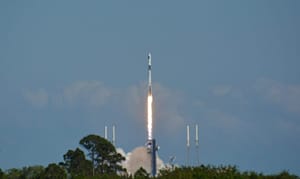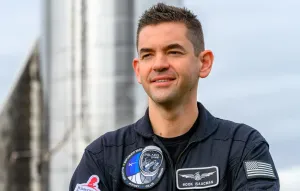
Mar 21, 2024
SpaceX launches its 30th cargo resupply mission
Late on the 21st of March, Falcon 9 lifted off from Space Launch Complex 40, in Florida, carrying a Cargo Dragon V2 spacecraft into orbit where it has since begun to chase down the International Space Station. The mission is SpaceX's thirtieth overall commercial resupply mission it is conducting on behalf of NASA to deliver cargo to the International Space Station.
This was the first time a Cargo Dragon V2 spacecraft had been launched from this launchpad. Space Launch Complex 40 has launched resupply missions prior when SpaceX used Cargo Dragon V1, the last resupply flight from the pad was CRS-20 in March of 2020.
Cargo Dragon V2 is carrying 2,841 kilograms of cargo to the International Space Station, with 2,210 kilograms being pressurized cargo and 631 kilograms being unpressurized cargo.

The booster that supported the launch of this mission was B1080 making its sixth flight and landing back at Landing Zone 1 in Florida. B1080 has previously supported the following missions: Ax-2, ESA's Euclid Telescope, Starlink Group 6-11, Starlink Group 6-24, and Ax-3.
The Cargo Dragon V2 spacecraft conducting the resupply mission is believed to be C209 and is making its fourth trip to space. C209 has previously flown the following resupply missions: CRS-22 in June of 2021, CRS-24 in December of 2021, and CRS-27 in March of 2023.
NASA currently plans to have Cargo Dragon C209 docked to the International Space Station for thirty days before it leaves and returns to Earth. C209 will dock to the Zenith, or space-facing, port of the Harmony module on the 23rd of March. While the Cargo Dragon V2 spacecraft docks it will be monitored by NASA astronauts Loral O'Hara and Dr. Michael Reed Barratt, as the spacecraft is capable of docking autonomously.

What's going up on Dragon?
The items from this section are from NASA and can be found along with more information here.
- Oxygen Generation Assembly Pump: The assembly pump converts potable water from the water recovery system into oxygen and hydrogen. The oxygen is sent to the crew cabin and the hydrogen is either vented or used to produce more water. This pump will maintain sparing on orbit.
- Pump Module Assembly: The assembly provides coolant and regulated flow to the radiator in order to maintain proper temperature for the Direct Current to Direct Current Converter Unit, the Main Bus Switch Unit, and the interface heat exchanger. This unit will maintain sparing on orbit.
- ARED (Advance Resistant Exercise Device) Right Upper Stop Cable: A cable mechanism attached to ARED bar which will allow crew to rack and unrack equipment during exercise. The mechanism will maintain sparing in orbit.
- Hatch Handle Alignment Guide: The guide ensures the proper hatch handle configuration for return vehicle operations.
- Toilet Pretreatment Package (Dose Pump): The toilet dose pump mixes water and alternate pretreat concentrate from separate sources, flows it through the toilet pretreat quality sensor, and injects it into the urine hose block. The toilet pretreat quality sensor measures the conductivity of the pretreat and water mixture. This installation will enable a new upgraded on-orbit toilet.
- Potable Water Dispenser Filter Assembly Unit: The filter unit, installed into the potable water dispenser on the station, will provide the capability to remove iodine from the water before the crew consumes it in food and drink packages. The unit contains two filters, a de-iodination filter and a 0.2-micron filter, which will be launched as a spare.
- Animal Enclosure Module: A next-generation design of the rodent habitat for the space station. The structure, an anodized aluminum enclosure with an internal stainless-steel cage, is a front breather with enhanced video, LED lighting, and sound reduction. An aluminum box provides water contained in pressurized bags to the specimens. The water can be refilled from the front quick disconnect and three-way valve. Inlet and outlet filters provide odor and waste containment. On orbit, the entire assembly is housed within a powered locker in the hardware storage rack.
- Animal Transporter: A powered animal module containing live rodents for ascent, return, and animal transfer operations on orbit. In a powered configuration, the module provides air exchange, food, water, and lighting. In a passive configuration, live animals are not in the enclosure. The transporter has foam strips mounted externally to provide vibration isolation and is the prime physical interface to the locker used in transport to the space station. The transporter will launch with water, food bars, and up to 20 rodents.
- Catalytic Reactor Startup Filter: The filter is used with the catalytic reactor installation to capture catalyst debris generated in the catalytic hardware during launch and before processing wastewater can begin. This will launch to maintain sparing.
- Vibration Isolation and Stabilization System Mass Tray: The tray supports the Vibration Isolation and Stabilization System on the European Enhanced Exploration Exercise Device. Two numbered trays each will house two tungsten plates when assembled. The trays will be stacked together to become the upper counter mass in support of the exercise device technology demonstration.
- Nitrogen Oxygen Recharge System Regulator: The regulator reduces pressure during transfer of oxygen to airlock supply systems. This will replace the existing unit noted to contain debris on the last restock and resupply of oxygen tanks.
- Crew Quarters Acoustic Blankets: The blankets are used in the crew quarters to provide noise mitigation. These blankets will replace blankets in all four crew quarters.
- Compatible Water Container-Iodine: The container, with a capacity approximately 45 pounds of fluid, stores iodinated water to be used in the coolant loop.
- Solid Fuel Ignition and Extinction Sample Spinner: A hardware insert for the combustion integration rack that enables a range of solid material combustion and fire suppression studies.
What's coming back on Dragon later?
- Common Cabin Air Assembly Heat Exchanger: The exchanger performs heat-transfer functions and removes moisture from the ambient on-orbit air. This unit is being returned for analysis and repair and then returned on a later flight.
- Oxygen Generation Assembly Pump: The pump converts potable water from the water recovery system into oxygen and hydrogen. The oxygen is sent to the crew cabin and the hydrogen is either vented or used to produce additional water. The pump is being returned for repair and will return on a later flight.
- Air Quality Monitor: The monitor is intended to improve the air analysis aboard the space station by measuring volatile organic compounds. The monitor is being returned for potential refurbishment of some of its components.
- Water Separator Orbital Replacement Unit: The unit draws air and condensate mixture from a condensing heat exchanger and separates the two components. The air is returned to the cabin air assembly outlet air-flow stream and the water is delivered to the condensate bus. The unit is being returned for repair.
- Emergency Mask: This unit will be returned to replace retaining rings.
- Emergency Portable Breathing Apparatus O2 Reducer Cylinder Assembly: A cylinder tank that provides 15 minutes of oxygen to a crew member in case of an emergency and is used with a quick don mask. This unit has been depressed and will be inspected, placed in line for refill, and relaunched at a later date.
- Remote Power Controller Module: The module distributes 120 volts of direct current electrical power and provides current limiting and fault protection to secondary loads aboard the space station. Both units are degraded, returning for repair, and will be reworked.
- Separator Plumbing Assembly: Supporting the urine processor assembly, the separator plumbing assembly receives steam condensate from the pressure control and pump assembly and recovers water from the orbital replacement unit. The separator plumbing assembly also controls the flow of water to the fluids control and pump assembly and can detect a pressure regulator failure. It is being returned for refurbishment.
What is Cargo Dragon V2?
Cargo Dragon V2 is a partially reusable spacecraft developed by SpaceX. The primary use for Cargo Dragon V2 is to send cargo to and from the International Space Station. Cargo Dragon V2 consists of the capsule and trunk.

The trunk is used to store unpressurized cargo as well as have solar panels mounted on one side, to generate power, and radiators on the other, to dissipate heat generated inside. The trunk is not reused and burns up in the atmosphere after each mission. Unlike Crew Dragon, Cargo Dragon V2's trunk has two fins due to it lacking the ability to escape from Falcon 9 in the event of a launch failure.
The capsule is used to store pressurized cargo, this could include small living creatures that will undergo experiments onboard the International Space Station. The capsule also has a nosecone that will fold out of the way in space to protect the docking hardware and forward-facing thrusters during launch and landing. The forward-facing thrusters are the main propulsion system for performing maneuvers while in flight. Cargo Dragon V2's capsule is the only part of the spacecraft that can survive returning to Earth.
The original Cargo Dragon was developed as part of NASA's Commercial Orbital Transportation Services program to deliver cargo to the International Space Station. Cargo Dragon V1 would provide SpaceX with valuable insights and experience for it to develop Crew Dragon, which led to the introduction of Cargo Dragon V2.



